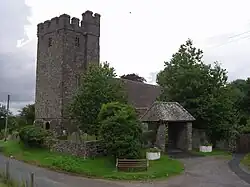Llanfair-y-bryn is a community and Church in Wales parish in Carmarthenshire, Wales. Covering an area of some 95 km², it lies along and to the northwest and southeast of the A483 Swansea to Chester road immediately north of the town of Llandovery.[1] The population of the community at the 2011 census was 624.[2] The term also referred to a church located outside the parish.
Description
Two particularities of Llanfair-ar-y-bryn (meaning: "St Mary's on the hill") are that
- the community and parish contain no settlement of that name: in 1801 it comprised the hamlets of Rhandir Abbot, Rhandir Canol, Rhandir Isaf, and Rhandir Uchaf;[3] today the principal settlements are Cynghordy and Rhandir-mwyn
- the parish church was, until 1883, located one mile outside the parish itself, in Llandingad (Llandovery); in 1883 a new church (also called St Mary's) was opened at a more central location in Cynghordy.
The area is served by trains operated between Swansea and Shrewsbury via Llandrindod Wells by Transport for Wales, which manages Cynghordy railway station, a request stop on the Heart of Wales Line from Llanelli to Craven Arms.
The community is bordered by the communities of: Myddfai; Llandovery; and Cilycwm, all being in Carmarthenshire; by Llanddewi Brefi in Ceredigion; and by: Llanwrtyd Wells; Llangamarch; Maescar; and Llywel, all in Powys.
The old parish church, Llanfair-ar-y-bryn

The original Church of St Mary stands a mile outside the parish on the northeastern edge of Llandovery, on the site of the Roman auxiliary fort of Alabum.[4]
William Williams Pantycelyn (1717–1791), generally acknowledged as one of Wales's greatest hymn writers, is buried in the churchyard there, having been a resident of the parish for much of his life.